Introduction
The Jammu and Kashmir is having a rich biodiversity of plants playing an important role not only in the regional ecosystem and but also in economy.1 The local people are affiliated with agriculture and allied services.2 Plants are utilized for a variety of purposes like medicine, food, fodder, timber, many do possess religious value and many more. All these uses are the source of economy for few or large number of people. Many species have led to thriving industries contributing potential amount of money to the local economy.3 Many plant taxa are considered as the basic constituents of the local cuisine (Wazwan) which is an important livelihood source of many people in the valley of Kashmir.4 Variety of species like deodar are important in the local construction form time immemorial paving a path to generate money for related people.5 According to Bhat et al.,6 plant taxa are the backbone to the local economy in Jammu and Kashmir. Ahad et al.,3 reported the economic importance of traditional wild food plants gathered by the local inhabitants of Gurez, Jammu and Kashmir, India. Similar other studies include Ahad Aziz et al.,12; Nafeesa et al.,2; Hassan et al.1
Economic plants are those utilized for the direct or indirect benefit of humanity. Indirect utilization encompasses meeting the needs of human livestock and contributing to the upkeep and enhancement of the environment. The advantages derived from economic plants may manifest in domestic, commercial, or aesthetic realms.7 Economic ethnobotanists have endeavored to describe the dependence of humans on plants for economic benefits from a very long time.8 We see a huge literature in the said realm across the globe, however in the Union territory of Jammu and Kashmir the no such study has been carried out in the region “Karnah”. Finding the research gap the present study was carried out to evaluate the importance of plant taxa in the economy of local inhabitants of Karnah (administrative region).
Materials and Methods
Study Area
Jammu and Kashmir, historically one of India’s largest princely states, has recently undergone a profound transformation with its reorganization into two distinct union territories: Jammu & Kashmir and Ladakh, orchestrated by the Central Government of India. This region’s geographical intricacy is underscored by its adjacency to the Uygur Autonomous Region of Xinjiang in China to the northeast, the Tibet Autonomous Region to the east, and the Chinese-administered portions of Kashmir.1 To the south, it shares borders with the Indian states of Himachal Pradesh and Punjab, while its southwestern boundaries adjoin Pakistan, and to the northwest, it converges with the Pakistani-administered segment of Kashmir. The Kashmir region is further divided into 20 administrative districts with Kupwara as on the extreme north sharing its borders with the Pakistan. Located within the Kupwara, Karnah is a tehsil situated 180 km north of Srinagar and approximately 80 km from the district headquarters, Kupwara, positioned at 34.39′ N latitude and 73.86′ E longitude (refer to Figure-1). The topography of the region spans altitudes ranging from 1380 to 3300 meters above sea level. According to the 2011 census, Karnah sustains a population of 60,129 individuals, with predominant languages being Pahari, Gojjari, and Kashmiri. The overall literacy rate stands at 63.65% based on the 2011 census data
Agriculture stands as the cornerstone of the Kashmir Valley,9 entwined with a symphony of allied services. Beyond the agrarian fields, the community unfolds in myriad livelihoods, with some engaged in trade, others as daily laborers, semi-skilled artisans, and shepherds, each contributing uniquely to the vibrant mosaic of this land. According to the anthropological survey of India, under people of India project, 111 ethnic groups inhabit the erstwhile Jammu and Kashmir.11
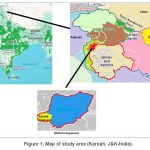 |
Figure 1: Map of study area (Karnah, J&K-India). |
Data collection
The present study was executed through field interviews conducted from February 2022 to August 2023 in administrative region “Karnah” of Kashmir Valley. A total of 97 informants, comprising 52% male and 48% female participants aged between 20 and 75 (as summarized in Table 1), were selected using a snowball technique. Prior to the informant selection, a reconnaissance survey was carried out in the region to gain familiarity, and the area head (sarpanches) was approached from where we started the selection of informants. The data collection process involved the application of semi-structured interviews, focus group discussions, and field observations, in accordance with established methodologies adopted by Aziz et al.,12. Information of significant interest encompassed plant species with economic value, their local nomenclature, growth habit, parts utilized, Questionnaires were administered in Urdu, facilitated by the inclusion of images and plant specimens collected during the interactions, which were instrumental in a specimen identification test. Individual interviews were conducted as required to supplement questionnaire responses. The study rigorously adhered to the ethical guidelines outlined by the International Society of Ethnobiology.
Table 1: Demographic status of the informants from the study area (Karnah, J&K).
| Region | Respondents | Percentage |
| Karnah | 97 | 100 |
| Language | Pahari, Urdu | |
| Gender | ||
| Women | 45 | 63.39 |
| Men | 52 | 53.61 |
| Age groups | ||
| 20-30years | 25 | 25.77 |
| 31-50 years | 30 | 30.93 |
| 51-75 65 years | 42 | 43.30 |
| Education | ||
| Illiterate | 52 | 53.61 |
| Primary | 27 | 27.84 |
| Secondary | 18 | 18.55 |
| Religion | ||
| Islam | 97 | 100 |
| Socio-economic status | Agriculture | |
Plant Identification
To ensure meticulous verification and the creation of herbarium specimens, we collaborated with knowledgeable informants from each survey site. For accurate plant identification, we relied upon regional literature sources.9,10,13 In cases where disagreements arose over local nomenclature, a group consensus was reached through rigorous debates. To achieve precise taxonomic identifications, the collected specimens underwent comprehensive scrutiny, with the invaluable guidance of taxonomists affiliated with the Glocal University in Saharanpur- India. Additionally, the correctness of nomenclature was confirmed through reference to The Plant List (TPL) (http://www.theplantlist.org) in an effort to uphold the highest standards of accuracy and scientific rigor.
Data Analysis
A cord diagram was employed as a graphical representation to illustrate the prevalent utilization patterns of different plant parts within the compiled species dataset (3). For a quantitative analysis of the relationships between each species and economic use, analysis was conducted using PAST software (version 3.14).
Results and Discussion
Diversity of Plants species with economic uses
Plant species serve as vital sources of sustenance for rural populations worldwide. In the current study, a comprehensive inventory of n=28 plant species, encompassing 20 taxonomic families, was documented through informant reports (Table 2). The preeminent family among these was Pinaceae (14%) (Figure 2a). The association of family species relationship (y = 0.0263x + 1.1737 R² = 0.0423) is shown in Figure 2b. R represents the linear association between the selected variables. This prominence of Pinaceae can be attributed to the region’s amenable environmental conditions and habitat suitability for their proliferation. Moreover, the local populace possesses extensive ecological and traditional knowledge concerning these families (9,14). Upon analyzing the results, the most prevalent life form among the documented species was trees (n=18), herbs (n=10), trailed by shrubs (n=1) (Table 2). Further, the documented were categorized into wild and cultivated; the wild species (n=16) displayed an ascendency over the cultivated (n=12). These findings align with earlier research conducted in the Western Himalayas (1, 9). A comprehensive inventory of the cataloged species is available in Table 2. The utilization of these documented species within the area can be attributed to factors such as plant diversity, accessibility, deep-seated knowledge of plant species, the healthy state of forest flora, and economic benefits.
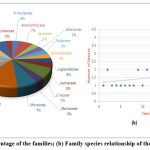 |
Figure. 2: (a) Percentage of the families; (b) Family species relationship of the documented species. |
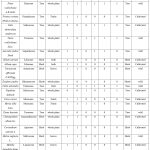 |
Table 2: Inventory of documented species with economical uses. |
Part usage
Different plant parts were documented for economic uses, and there was a significant difference (χ2=90.587, df=7, p<0.001) between their uses. Based on the cord diagram, a variety of plant parts find application in diverse economic uses, with whole plant (n=18), leaves (n=7), fruits (n=6), seeds and bulb (n=2 each) representing the most frequently used components (Figure 3a). The maximum usage of the “whole plants” can be attributed to multi-usage, (i.e medicine, fuel, timber, etc) The prominent species of which whole plants were used are Abies pindro, Acer caesium, Cedrus deodara, Juglans regia, Picea smithiana, Pinus wallichiana, Chenopodium album, Coriandrum sativum. Likewise, plants from which fruits were employed include, Juglans regia, Prunus cornuta, Celtis tetrandra, Ficus carica, Morus alba, Cynodia oblanga. Species from which seeds were used are Celosia argentea, Pinus wallichiana and species from which blub are exploited are Allium sativum, Allium cepa. Ahad et al.,3 reported the different parts of plants for economical uses form the northern Himalayas. Among the documented parts, the Whole plant contributed (51%), followed by leaves (20%), fruits (17%), bulb and seeds (6% each) (Figure 3b). The maximum use of the whole plant can be attributed to the cost-effective ness.
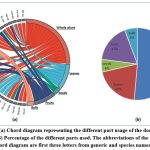 |
Figure. 3: (a) Chord diagram representing the different part usage of the documented species; (B) Percentage of the different parts used. The abbreviations of the species in the chord diagram are first three letters from generic and species names each. |
Important usage contributing economy
All documented species play an important role in the economy of the region by servicing different day today needs. In the present study we recorded a total of six uses (Medicine, food, timber, fuel aesthetic, and industrial use) contributing to the economy and livelihood in the region (Figure. 4). The maximum number of species (n=25) were found to be used in traditional medicine followed by (n=16) for food, fuel (n=12), timber (n=11), industrial use (n=11) and aesthetic (n=8) (Figure. 4). It is important to mention that the maximum number of species are used in traditional medicine, however, in spite of the maximum number the species used in timber contribute maximum in the economy. For instance, species like Cedrus deodara, Pinus wallichiana, are most important playing an important role in the local construction (houses, government buildings, huts, hotels, restaurants). Further, Juglans regia listed in our food category, has led to an important cottage industry. The kernels obtained form are exported to the other parts of the country and out of the country generating a potential revenue. Similarly, Allium staivum and Allium cepa are very important to the local cuisine (Wazwan), hence are easily available in the market serving the economy of local farmers; Malva neglecta, Cynodia oblanga are unique used in the newly lactating mother for nutrition and immune boosting respectively, hence play an important role in the livelihood of traditional healers. In the higher parts of the region with less connectivity of roads the people use variety of the species like Celtis tetrandra, Abies pindrow, Acer caesium, Cedrus deodara, Pinus wallichiana for fuelwood. In this regard many people use collect the dried parts of the species and then sold to the inhabiting people at low prices. Some times in return they demand for many items for food making like turmeric, salt etc. Species like Cedrus deodara, Juglans regia are also used in making furniture, windows, doors, wood paneling, cupboards hence play avital role in the industrial purposes. With the current pace of urbanization people are also interested in the aesthetic value of species hence many people take the advantage of this and sellout the species with said attribution and generate the handsome money, the prominent species from this category are Salix denticulate, Aesculus indica, Taxus wallichiana. Our results are in accordance with Mace et al.,15; Gómez et al.:16 Rees and Wackernagel.17
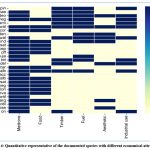 |
Figure 4: Quantitative representative of the documented species with different economical attributions |
Conclusion
In Conclusion, the study has illuminated the importance of the local plant taxa in the economy of the people inhabited in the administrative region (Karnah). The plant species are utilized via different mode (i.e., medicine, food, timber, fuel wood, industrial use, aesthetic) ultimately providing an important livelily hood and economic boost to the local populace. It is important to note that people which are disconnected via road use variety of species for fuelwood which in turn has a potential to cause forest fires, respiratory diseases. Further, the unchecked use of the species for variety of purposes to generate money can cause eradication of various species from the region leading the mass extension. In this regard, awareness programs are need to generate awareness among the people using print electronic media, seminars, workshops. Also, the local stakeholders to draft the policies which will assist the use of the local flora via applying scientific approach.
Acknowledgment
Thanks are due to the local people of Karnah, Jammu and Kashmir for cooperating during the surveys and interviews. The authors are thankful to those who directly or indirectly helped us during the study.
Funding Sources
Present didn’t receive any kind of funding from any private or public source.
Conflict of Interest
The authors declare that they have no competing interests.
Ethics Approval and Consent to Participate
All the participants provided prior informed consent before the interviews. The ISE code of ethics was followed.
Availability of Data and Materials
All the required data is provided the article.
Authors’ Contribution
All authors contributed equally.
References
- Hassan M., Abdullah A., Haq SM., Yaqoob U., Bussmann RW., Waheed M. Cross-ethnic use of ethnoveterinary medicine in the Kashmir Himalaya-A Northwestern Himalayan region. Acta Ecol. Sin. 2023;43(4):617-27.
CrossRef - Nafeesa Z, Haq SM, Bashir F, Gaus G, Mazher M, Anjum M, Rasool A, Rashid N. 2021. Observations on the floristic, life-form, leaf-size spectra and habitat diversity of vegetation in the Bhimber hills of Kashmir Himalayas. Acta Ecologica Sinica 41(3):228-234.
CrossRef - Ahad L., Hassan M., Amjad MS., Mir RA., Vitasović-Kosić I., Bussmann RW., Binish Z. Ethnobotanical Insights into Medicinal and Culinary Plant Use: The Dwindling Traditional Heritage of the Dard Ethnic Group in the Gurez Region of the Kashmir Valley, India. Plants. 2023;12(20):3599.
CrossRef - Sheikh A.M. Kashmiri Wazwan: A Multicultural Repository. Language in India. 2011;11(6).
- Dar AR., Dar G.H. The wealth of Kashmir Himalaya-gymnosperms. Asian J.Plant Sci. 2006;5(2):251-9.
CrossRef - Bhat F., Mahajan DM., Bhat. A. Assessment of anthropogenic activities and exotic flora of Lolab valley, Kashmir, India. j. bioassays. 2015;4:4483-91
- Ghazanfar S.A. Plants of economic importance. InVegetation of the Arabian Peninsula 1998 (pp. 241-264). Dordrecht: Springer Netherlands.
CrossRef - Phillips OL., Meilleur B.A. Usefulness and economic potential of the rare plants of the United States: a statistical survey. Eco Bot. 1998:57-67.
CrossRef - Liu F, Gao C, Chen M, Tang G, Sun Y, Li K. 2021. The impacts of flowering phenology on the reproductive success of the narrow endemic Nouelia insignis Franch. (Asteraceae). Ecology and Evolution. doi: 10.1002/ece3.7747.
CrossRef - Umair M, Altaf M, Bussmann RW, Abbasi AM. 2019. Ethnomedicinal uses of the local flora in Chenab riverine area, Punjab province Pakistan. Journal of Ethnobiology and Ethnomedicine 15(1):1-31. doi:10.1186/s13002-019-0285-4
CrossRef - BHAT FA., Mathur P.K. Ethnic plurality in Jammu and Kashmir: A sociological analysis. Man in India, 2011. 91;(3-4):577-596.
- Aziz MA., Ullah Z., Al-Fatimi, M., De Chiara M., Sõukand, R., Pieroni. A. On the trail of an ancient Middle Eastern Ethnobotany: Traditional wild food plants gathered by Ormuri speakers in Kaniguram, NW Pakistan. Biology 2021; 10: 302.
CrossRef - Menon V. Indian Mammals: A Field Guide; Hachette India: Delhi, India, 2014.
- Shaheen H, Islam M, Ullah Z. 2014. Indigenous ethnobotanical remedies practiced to cure feminine diseases in tribal communities of Kashmir Himalayas. International Journal of Phytomedicine 6(1):103.
- Mace GM., Norris K., Fitter A.H. Biodiversity and ecosystem services: a multilayered relationship. Trends Ecol. Evol. 2012;27(1):19-26.
CrossRef - Gómez-Baggethun E, Barton D.N. Classifying and valuing ecosystem services for urban planning. Ecol Eco. 2013;86:235-45.
CrossRef - Rees W, Wackernagel M. Urban ecological footprints: why cities cannot be sustainable and why they are a key to sustainability. Urban ecology: an international perspective on the interaction between humans and nature. 2008:537-55.
CrossRef

